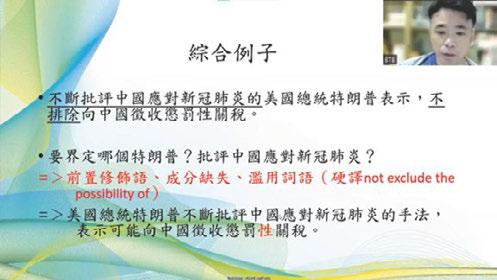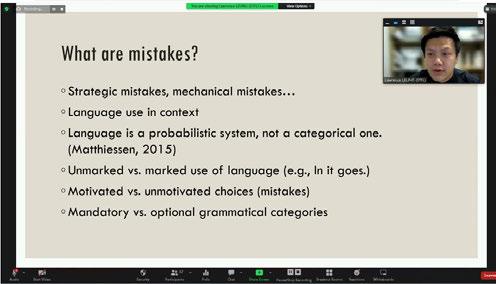
1 minute read
STFL Public Lectures - Found in Translation: Common Mistakes in Chinese and English Usage 翻譯及外語學院公開講座-翻譯學堂:常見中英文誤區
Translation in Hong Kong mainly involves Chinese and English. Mistakes in language usage in translation naturally occur in our daily life. In view of this, two public lectures on common mistakes in Chinese and English usage in Hong Kong were hosted by the School of Translation and Foreign Languages (STFL) on 14 May 2022 and 21 May 2022 respectively. Mr William Che, Lecturer of STFL, delivered a public lecture entitled ‘Found in Translation: Common Mistakes in Chinese Usage’. In the talk, Mr Che gave a brief introduction to the common mistakes in Chinese usage. He pointed out three common mistakes related to translation, namely overliteral translation, Europeanised phrases, and Europeanised syntax. Overliteral translation is illogical and often involves the overuse of some common structures, while Europeanisation typically occurs in sentence structures through translation, causing imprecision or repetition in meaning. Mr Che also cited several examples from daily life to illustrate the common mistakes in Chinese usage seen in Europeanised phrases and syntax. He remarked that Chinese phrase structures are subject to more constraints than English ones, stressing that we should avoid over-correction in making judgment about mistakes in Chinese usage, and that we should differentiate between ungrammatical and illogical structures. Subsequently, Mr Lawrence Leung, Senior Lecturer of STFL, delivered another online public lecture entitled ‘Found in Translation: Common Mistakes in English Usage’. Mr Leung introduced different kinds of mistakes in English usage, focusing on grammatical ones. He compared Traditional Grammar and Systemic Functional Grammar with examples, explaining that a word might be polysemous and can serve different functions. He then demonstrated how to deal with English articles in translation and analysed the structures of different English tenses. Mr Leung concluded the talk by encouraging the audience to pay attention to the differences between Chinese and English grammar in order to avoid making mistakes during translation. 香港的翻譯活動以中英文為主,翻譯的語用問 題可見於日常生活。有見及此,翻譯及外語學 院於 2022 年 5 月 14 日及2022年5月21日 分別舉辦兩場公開講座,討論香港的常見中英 文語病。
Advertisement
Mr Che cites an example from daily life to explain the mistakes in Chinese usage seen in translation. 池先生引用日常生活例子說明與翻譯相關的常見中文語病。 Mr Leung introduces different kinds of common mistakes in English usage. 梁先生介紹各種英語用法的常見錯誤。











